Discover 35 hidden attractions, cool sights, and unusual things to do in Helsinki (Finland). Don't miss out on these must-see attractions: Suomenlinna, Kiasma, and Market Square. Also, be sure to include Ateneum in your itinerary.
Below, you can find the list of the most amazing places you should visit in Helsinki (Southern Finland).
Table of Contents
Suomenlinna

Fortress in Helsinki, Finland. Suomenlinna, or Sveaborg, is an inhabited sea fortress built on eight islands about 4 km southeast of the city center of Helsinki, the capital of Finland. Suomenlinna is popular with tourists and locals who enjoy it as a picturesque picnic site. Originally named Sveaborg, or Viapori as referred to by Finnish-speaking Finns, it was renamed in Finnish to Suomenlinna in 1918 for patriotic and nationalistic reasons, though it is still known by its original name in Sweden and by Swedish-speaking Finns.
The Swedish crown commenced the construction of the fortress in 1748 as protection against Russian expansionism. The general responsibility for the fortification work was given to Augustin Ehrensvärd. The original plan of the bastion fortress was strongly influenced by the ideas of Vauban, the foremost military engineer of the time, and the principles of the star fort style of fortification, albeit adapted to a group of rocky islands. Famous for these bastion fortifications, Suomenlinna became a UNESCO World Heritage Site in 1991.
During the Finnish War, Sweden surrendered the fortress to Russia on 3 May 1808, paving the way for the occupation of Finland by Russian forces in 1809, and the eventual cession of Finland to Russia at the conclusion of the war. Russia held the fortress until Finnish independence in 1918. Finland then managed Suomenlinna through the Defense Department until turning most of it over to civilian control in 1973.[1]
Kiasma
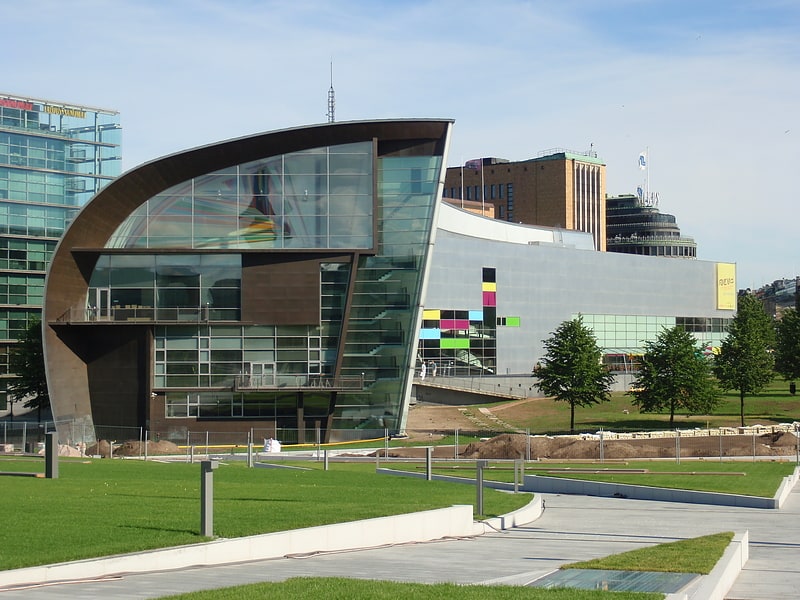
Contemporary art museum and theater. Kiasma is a contemporary art museum located on Mannerheimintie in Helsinki, Finland. Its name kiasma, Finnish for chiasma, alludes to the basic conceptual idea of its architect, Steven Holl. Kiasma is part of the Finnish National Gallery, and it is responsible for the gallery's contemporary art collection. Its central goal is to showcase contemporary art and to strengthen its status.[2]
Address: Mannerheiminaukio 2, 00100 Helsinki (Eteläinen)
Market Square
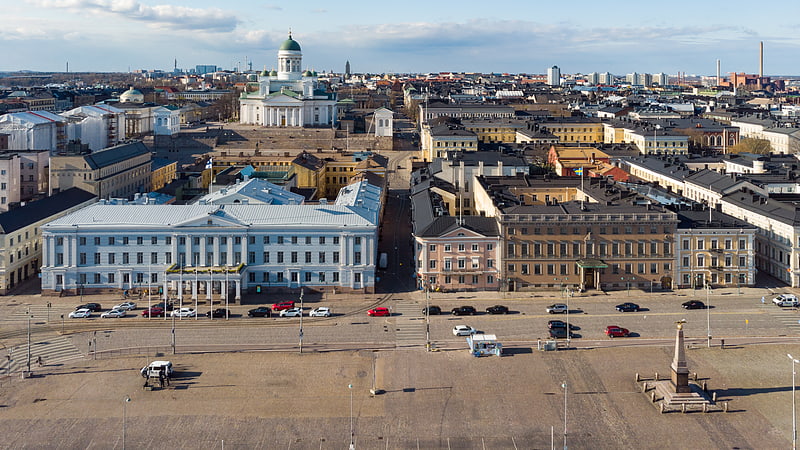
Also known as: Kauppatori
Market in Helsinki, Finland. The Market Square is a central square in Helsinki, Finland. It is located in central Helsinki, at the eastern end of Esplanadi and bordering the Baltic Sea to the south and Katajanokka to the east. HSL maintains a year-round ferry link from Market Square to Suomenlinna, and in the summer there are also private companies providing ferry cruises, both to Suomenlinna and to other nearby islands. The Presidential Palace, Helsinki City Hall, Swedish Embassy and the Stora Enso Headquarters building are all located adjacent to Market Square.
From spring to autumn, the Market Square is active with vendors selling fresh Finnish food and souvenirs. There are also many outdoor cafés at the square. Some cafés also provide meat pastries (Finnish: lihapiirakka).
The height of the square's popularity is in early October, when the annual Helsinki herring market (silakkamarkkinat) begins.
A long tradition at the Market Square is a display of old American cars on the first Friday of every month. Any motorist with an interest in old American cars may participate in the display.
Seagulls have become an increasing menace in the Market Square, swooping down to snatch snacks and ice cream from the hands of unsuspecting tourists.[3]
Address: Eteläranta, 00130 Helsinki, Helsinki (Eteläinen)
Ateneum
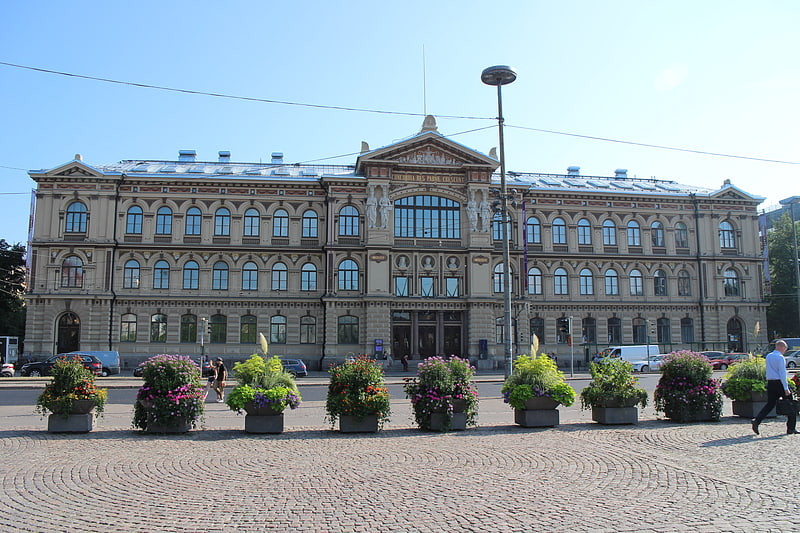
Museum of Finnish and international art. Ateneum is an art museum in Helsinki, Finland and one of the three museums forming the Finnish National Gallery. It is located in the centre of Helsinki on the south side of Rautatientori square close to Helsinki Central railway station. It has the biggest collections of classical art in Finland. Before 1991 the Ateneum building also housed the Finnish Academy of Fine Arts and University of Art and Design Helsinki.[4]
Address: Kaivokatu 2, 00100 Helsinki (Eteläinen)
Temppeliaukio Church
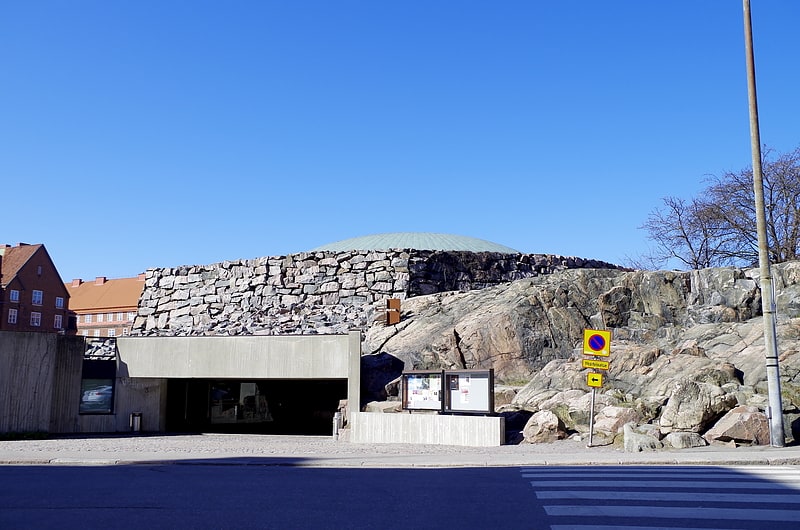
Also known as: Temppeliaukion kirkko
1960s church excavated into rock. Temppeliaukio Church is a Lutheran church in the Töölö neighborhood of Helsinki. The church was designed by architects and brothers Timo and Tuomo Suomalainen and opened in 1969. Built directly into solid rock, it is also known as the Church of the Rock and Rock Church.[5]
Address: Lutherinkatu 3, 00100 Helsinki (Eteläinen)
Helsinki Cathedral
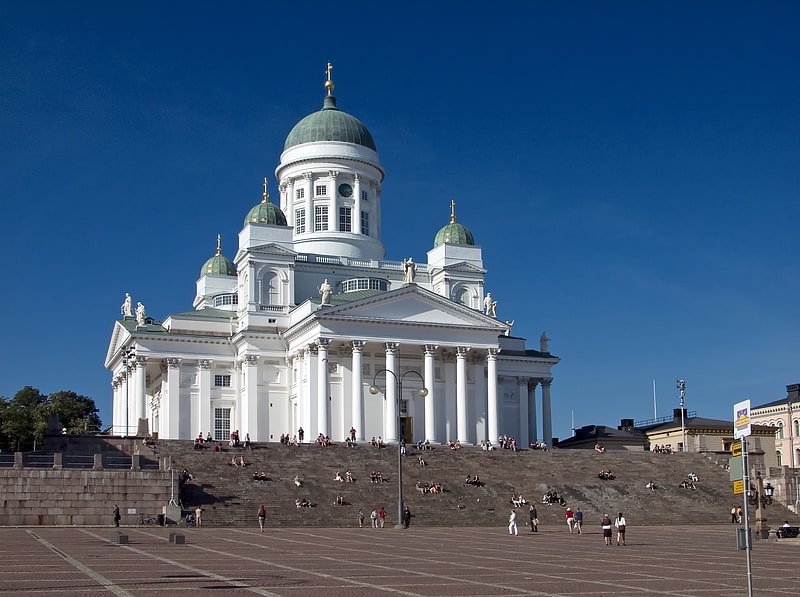
Also known as: Helsingin tuomiokirkko
Landmark 19th-century religious edifice. Helsinki Cathedral is the Finnish Evangelical Lutheran cathedral of the Diocese of Helsinki, located in the neighborhood of Kruununhaka in the centre of Helsinki, Finland at the Senate Square. The church was originally built from 1830–1852 as a tribute to the Grand Duke of Finland, Tsar Nicholas I of Russia. It was also known as St Nicholas's Church until the independence of Finland in 1917. It is a major landmark of the city, and possibly the most famous structure in Finland as a whole when viewed globally.[6]
Address: Unioninkatu 29, 00170 Helsinki (Eteläinen)
Uspenski Cathedral
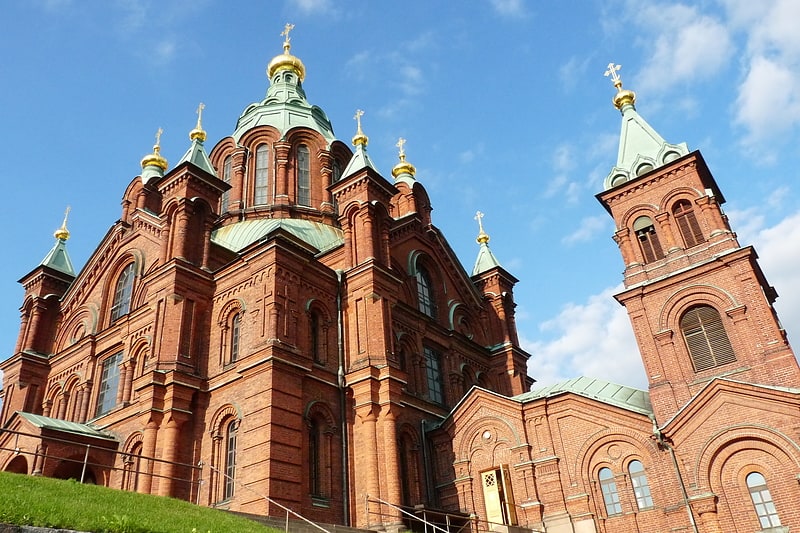
Also known as: Uspenskin katedraali
Russian-designed Orthodox cathedral. Uspenski Cathedral is an Eastern Orthodox cathedral in Helsinki, Finland, and main cathedral of the Orthodox Church of Finland, dedicated to the Dormition of the Theotokos. Its name comes from the Old Church Slavonic word uspenie, which denotes the Dormition.[7]
Address: Kanavakatu 1, 00160 Helsinki (Eteläinen)
Sibelius Monument
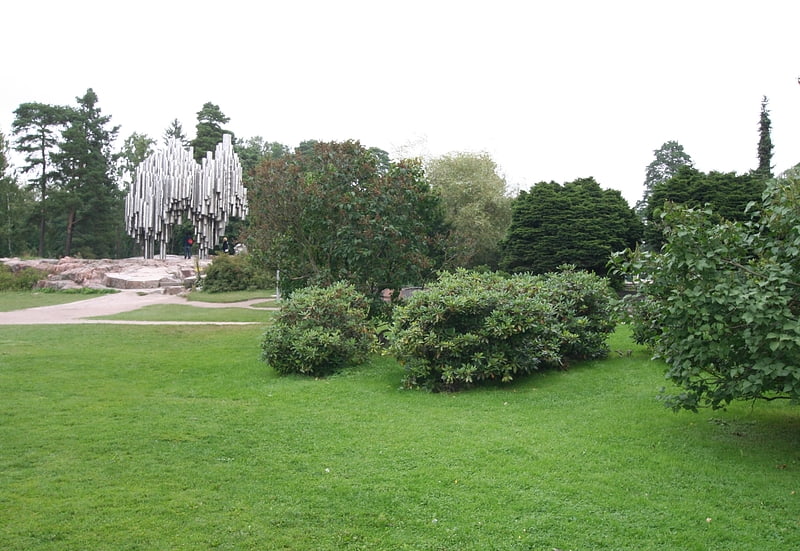
Also known as: Sibelius-monumentti
Part-abstract monument to composer. The Sibelius Monument by Eila Hiltunen is dedicated to the Finnish composer Jean Sibelius. The monument is located at the Sibelius Park in the district of Töölö in Helsinki, the capital city of Finland.[8]
Address: Sibelius Park, Helsinki (Eteläinen)
Hakaniemi
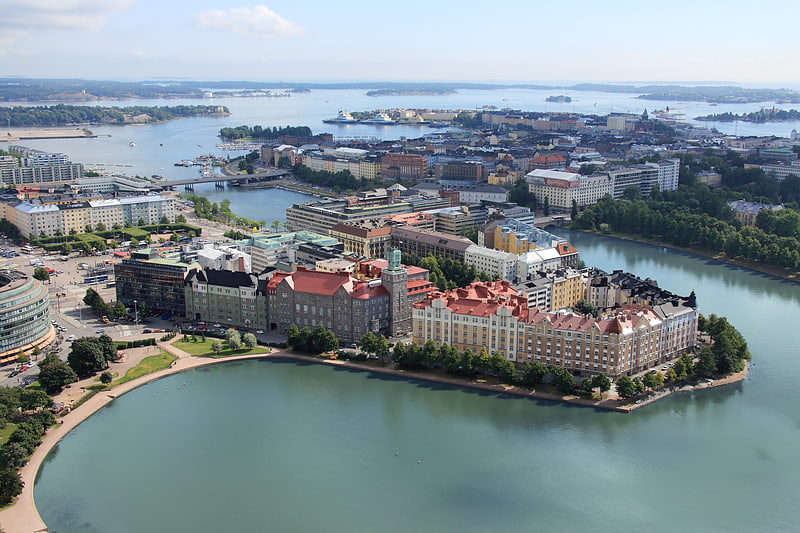
Hakaniemi is an unofficial district of Helsinki, the Finnish capital. It covers most of the neighbourhood of Siltasaari. It is considered a part of the Helsinki city center. Historically, it was often associated with the working class and workers' associations. However, the cost of living has risen considerably in recent years and is now on par with that of the rest of central Helsinki.
The best-known features of Hakaniemi include a large and lively marketplace, Oriental food stores with a good variety of Asian imported products the headquarters of several trade unions, the headquarters of the Social Democratic Party of Finland and the Left Alliance Party and the Helsinki Hilton hotel. Famous buildings include the round Ympyrätalo building (architects Heikki and Kaija Sirén, 1968) and the Hakaniemi Market Hall (architect Karl Hård af Segerstad, 1914).
The Hakaniemi market square was built on reclaimed land. It has been the site of a farmers' market since 1897.[9]
Address: Haemeentie 1a, 00530 Helsinki (Keskinen)
Presidential Palace
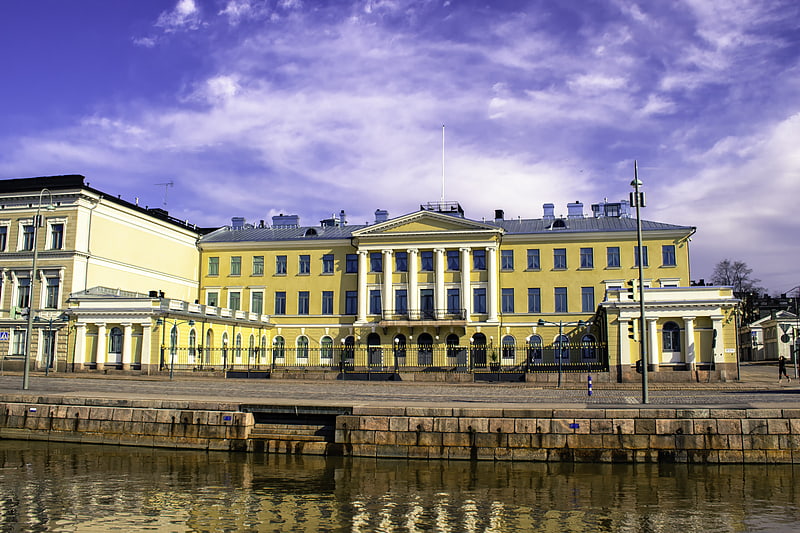
Also known as: Presidentinlinna
Presidential palace in Helsinki, Finland. The Presidential Palace is one of the three official residences of the President of the Republic of Finland. It is situated in Helsinki, on the north side of Esplanadi, overlooking Market Square.[10]
Address: Pohjoisesplanadi 1, 00170 Helsinki (Eteläinen)
Statue of Johan Ludvig Runeberg
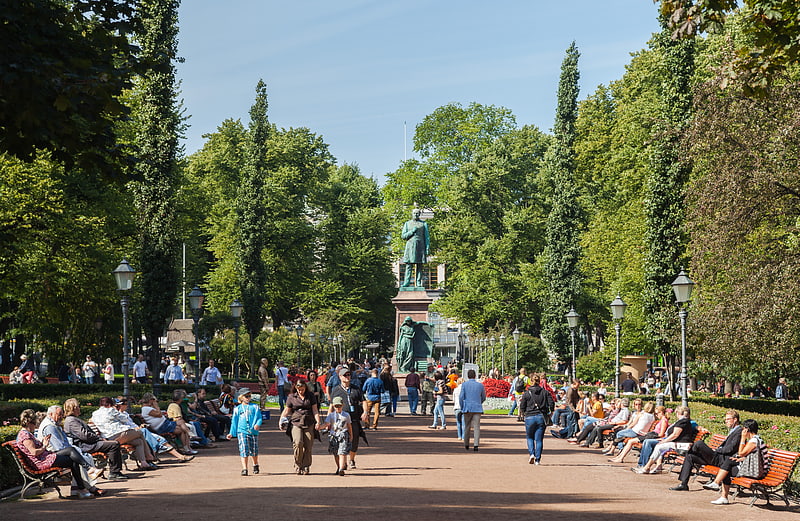
The Statue of Johan Ludvig Runeberg is a statue dedicated to the Finland-Swedish author, national poet and priest Johan Ludvig Runeberg, designed and sculpted by his son Walter Runeberg. The statue is located in the Esplanadi park in Helsinki.[11]
Havis Amanda
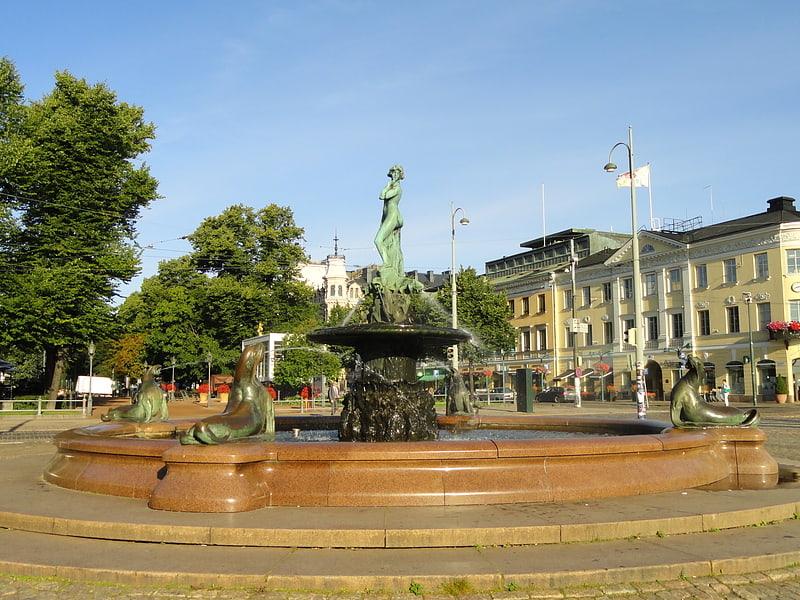
Bronze statue in Art Nouveau style. Havis Amanda is a fountain and a statue in Helsinki, Finland by the sculptor Ville Vallgren. The work was modelled in 1906 in Paris, and erected at its present location at the Market Square in Kaartinkaupunki in 1908. Today it is recognized as one of the most important and beloved pieces of art in Helsinki.[12]
Address: Unioninkatu 23, 00100 Helsinki (Eteläinen)
Suomenlinna Church
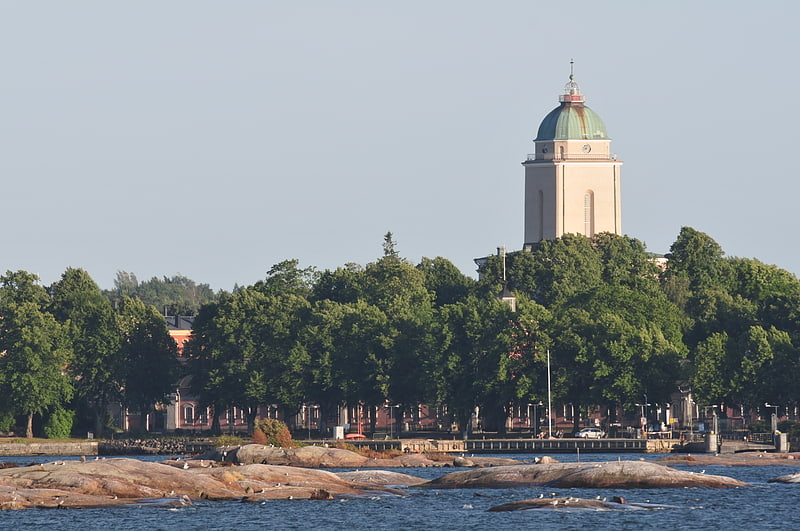
Also known as: Suomenlinnan kirkko
Former Orthodox church built in 1854. The Suomenlinna Church in Helsinki, Finland, was built in 1854 as an Eastern Orthodox garrison church for the Russian troops stationed at the Suomenlinna sea fortress. The fortress comprises five islands joined together by bridges, and the church is the central feature on the island of Iso Mustasaari, located at its highest point. It is surrounded by other fortress buildings, but the old parade ground is immediately to the east, and a park lies immediately to the south. It is oriented southwest to northeast so that it would align with the Crownwork Ehrensvärd defense front located to the southwest of the church.
Before the design and construction of the Orthodox church, plans were drawn up in the 1820s by architect Carl Ludvig Engel for a church on the same site, but designed in the neoclassical style in keeping with the rest of buildings at the fortress and the buildings in the capital city, Helsinki. The actual church was designed by Konstantin Thon, an official architect of Imperial Russia during the reign of Czar Nicholas I, whose major works included the Cathedral of Christ the Saviour, the Grand Kremlin Palace, and the Kremlin Armoury in Moscow. The church was named for Saint/Prince Alexander Nevsky, who defeated the Swedes at the Neva battle of 1240. The Alexander Nevsky Church originally had five onion domes. The perimeter fence, constructed from cannons and chains, was erected in the 1870s. The church bell, the largest in Finland, was cast in Moscow in 1885 and weighs 6,683 kilograms. It is now displayed adjacent to the church. The church was elevated to the status of cathedral within the Orthodox faith in 1891.
In 1918 the Orthodox church was converted into an Evangelical Lutheran church, as Finland sought to indicate its new-found independence from Russia. The onion domes of the four smaller towers were immediately removed. The church's extensive iconography was warehoused by the city of Helsinki, but their current whereabouts are unknown. During the 1920s, it was decided to give the church an extensive renovation for structural repair as well as incorporation of a more Western design. The design competition was won by architect Einar Sjöström, and the finished church was reconsecrated on 28 April 1929.
Another interesting feature from the renovation is that the church's central dome has doubled as a lighthouse since 1929, making it one of only a few churches in the world that has that dual purpose. The lighthouse is officially the Harmaja Range Rear light, and it pairs with the Harmaja lighthouse (4.8 km south in the Gulf of Finland) as the Range Front light. The signal blink is the Morse code for the letter "H" for Helsinki.
Additional renovations have been made in the 1960s (after the church was turned over to the Evangelical Lutheran Parish Union of Helsinki), and again in the late 1980s and 1990s in preparation for the 250th anniversary of Suomenlinna in 1998. The Suomenlinna Church is still a very popular wedding site and one of the first landmarks for people arriving in Helsinki by sea.[13]
Address: Suomenlinna C 3, 00190 Helsinki (Eteläinen)
Tamminiemi

Museum of the former president's life. Tamminiemi is a villa and house museum located in the Meilahti district of Helsinki, Finland. It was one of the three official residences of the President of Finland, from 1940 until 1981. From 1956, until his death, it served as the residence of President Urho Kekkonen. Since 1987, it has been the Urho Kekkonen Museum. It is located in a park by the sea. Tamminiemi's floor area is about 450 square metres; living quarters comprise the first two floors while the third floor is dedicated to office space.
Designed by architects Sigurd Frosterus and Gustaf Strengell, the Jugendstil villa was built in 1904 for the Danish-born businessman Jörgen Nissen. The villa was later owned or rented by a number of individuals, before being acquired by the publisher and artistic patron Amos Anderson in 1924. Anderson donated Tamminiemi to the Finnish state in 1940, to serve as a presidential residence.
Although Presidents Risto Ryti (1940–1944) and C. G. E. Mannerheim (1944–1946) did reside at Tamminiemi, while President J. K. Paasikivi preferred to use the Presidential Palace as his official residence during his presidency (1946–1956), the villa is particularly associated with President Kekkonen—due in large part to the fact that it was his official residence and home for around thirty years; during his period in office between 1956 and 1981, before becoming his private nursing home until his death in 1986.
In 1987, Tamminiemi was transformed into the Urho Kekkonen Museum. It is furnished the way it was in Kekkonen's time in the 1970s. In 1989, construction of the new presidential residence called Mäntyniemi started. An extensive renovation of Tamminiemi began in 2009 and was completed in 2012. The renovation restored the original exterior colouring and decorative motifs of the 1904 villa. Building technology was renewed, interior surfaces were cleaned and broken spots repaired, while preserving the minor signs of age-related wear, emphasizing the patina of Urho Kekkonen's time.
Tamminiemi also has a famous sauna in a separate building which Kekkonen built after being elected president in 1956. The sauna also includes a swimming pool and a recreation room with a fireplace. Kekkonen used the sauna facilities to entertain his domestic and foreign guests, including the Soviet leader Nikita Khrushchev. Nowadays the sauna can be rented for private events but availability is very restricted due to the sauna's cultural and historical value.[14]
Address: Helsinki, Seurasaarentie 15
Senate Square
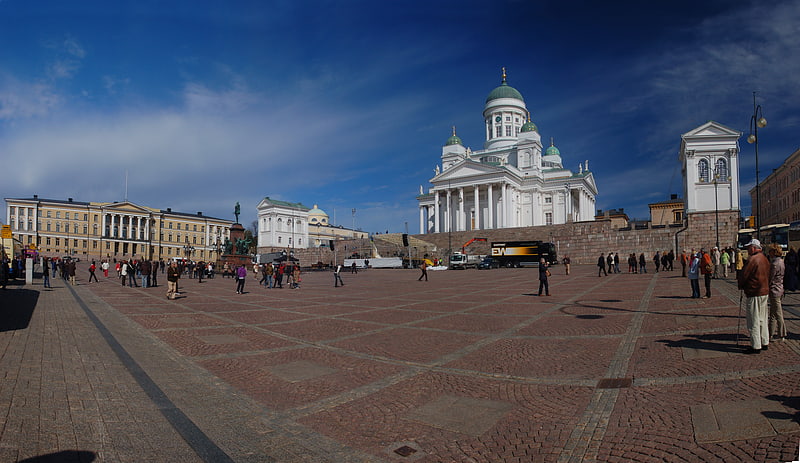
Also known as: Senaatintori
Neoclassical buildings on public square. The Senate Square presents Carl Ludvig Engel's architecture as a unique allegory of political, religious, scientific and commercial powers in the centre of Helsinki, Finland.
Senate Square and its surroundings make up the oldest part of central Helsinki. Landmarks and famous buildings surrounding the square are the Helsinki Cathedral, the Government Palace, main building of the University of Helsinki and the Sederholm House, the oldest building of central Helsinki dating from 1757.[15]
University of Helsinki Botanical Garden
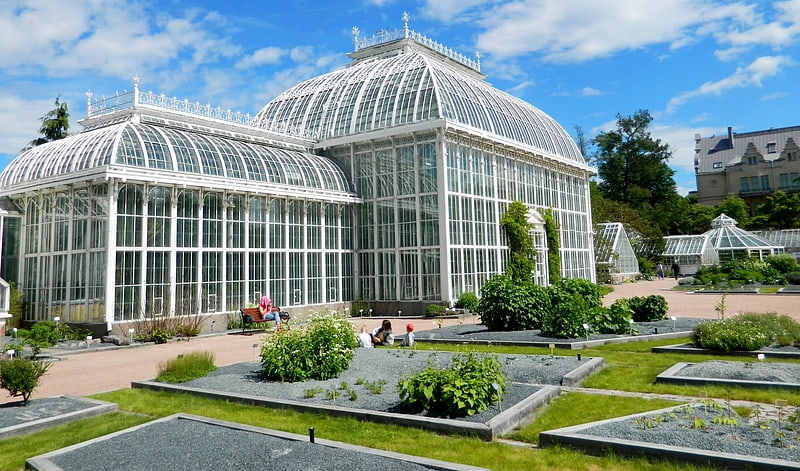
Also known as: Helsingin yliopiston kasvitieteellinen puutarha
Botanic garden based around a herbarium. The University of Helsinki Botanical Garden is an institution subordinate to the Finnish Museum of Natural History of the University of Helsinki, which maintains a collection of live plants for use in research and teaching. The Botanical Garden has two separate sites: one in Kaisaniemi and one in Kumpula.
The Kaisaniemi Garden is open to the public. Its greenhouse is currently home to more than 800 different species of plants and its grounds to more than 2,800 plants of different origins.
Construction on the Kumpula Garden started in 1987 and opened to the public in 2009.[16]
Address: Unioninkatu 44, 00170 Helsinki (Eteläinen)
Kirnu
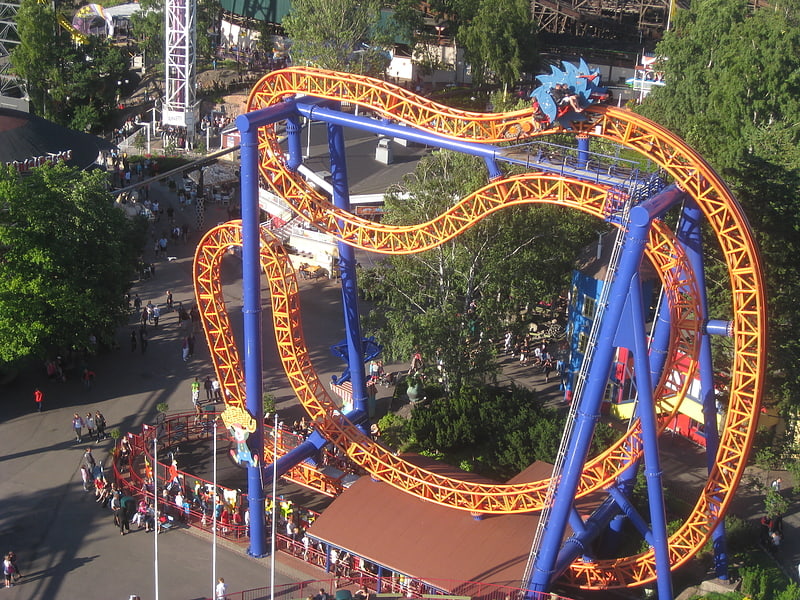
Roller coaster. Kirnu is a steel roller coaster located at the Linnanmäki amusement park in Helsinki, Finland. Kirnu is Intamin's first ball coaster.[17]
Address: Tivolikuja 1, 00510 Helsinki (Keskinen)
National Museum of Finland

Also known as: Suomen kansallismuseo
Museum of Finnish culture and history. The National Museum of Finland presents Finnish history from the Stone Age to the present day, through objects and cultural history. The Finnish National Romantic style building is located in central Helsinki and is a part of the Finnish Heritage Agency, under the Ministry of Culture and Education.[18]
Address: Mannerheimintie 34, 00100 Helsinki (Eteläinen)
Vuoristorata
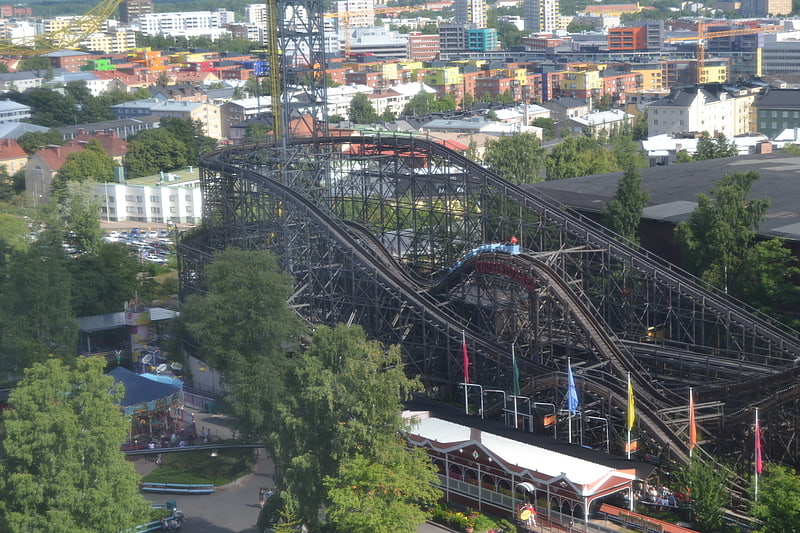
Roller coaster in Helsinki, Finland. Vuoristorata is a classic wooden roller coaster located at the Linnanmäki amusement park in Helsinki, Finland. It was built in the winter of 1950 by Linnanmäki's staff on the basis of drawings by the Danish builder Valdemar Lebech. The construction work was led by the Danish ride operator Svend Jarlström, who at the time owned most of Linnanmäki's rides. Vuoristorata was opened on 13 July 1951, and at the time, was the largest roller coaster in the Nordic countries. Expected to last up to 15 years, it was originally designed as a temporary attraction for the amusement park, opened in 1950. One of the main reasons for its construction was to attract tourists from the 1952 Summer Olympics held in the city. Since then, its temporary status was renewed for extended periods, until it was eventually regarded as a permanent structure.
Since its opening in 1951, Vuoristorata has been the most popular ride at Linnanmäki every year. It is the most famous amusement ride in Finland, and a symbol of the Linnanmäki park; even the old park logo had a shape representing the ascents and descents of Vuoristorata. Vuoristorata has never had a name other than the common noun used for roller coasters; Vuoristorata simply means "roller coaster" in Finnish (lit. vuoristo = mountain range, rata = track; mountain range track).
Vuoristorata is notable for being the last built roller coaster in the world to use side friction technology. It is a copy of another roller coaster, Rutschebanen, opened in 1932 at Dyrehavsbakken in Denmark. Valdemar Lebech, who designed both of these and a few other tracks, simply took the original blueprints of Rutschebanen, which had been downscaled due to changes in location, and designed Vuoristorata. Back in the 1950s, Rutschebanen and Vuoristorata were the two tallest roller coasters in Europe; Vuoristorata is slightly taller and longer of the two.
Vuoristorata is one of only seven roller coasters in the world that are still operated by brakemen, including five others in Europe and one in Australia. From June 2021, Linnanmäki has switched to gender-neutral job titles, as a result of which the former title "brakeman" (Finnish: jarrumies) is now called the "brakemaster" (jarrumestari). During the 2021 season, 16 people worked as brakemasters, including one female.
Over the decades, Vuoristorata has been carefully maintained. To ensure safety, all the wooden parts have been gradually replaced at least five times. All that remains of the original structure from the 1950s are the oak-framed wooden cars. In order to preserve the original layout, subsequent restorations have been carried out carefully; although all the wooden parts are replacements, they are consistent with the original design and character of the track.
Vuoristorata is among the few roller coasters in the world to have been awarded the ACE Coaster Classic status by the American Coaster Enthusiasts.[19]
Villa Hakasalmi
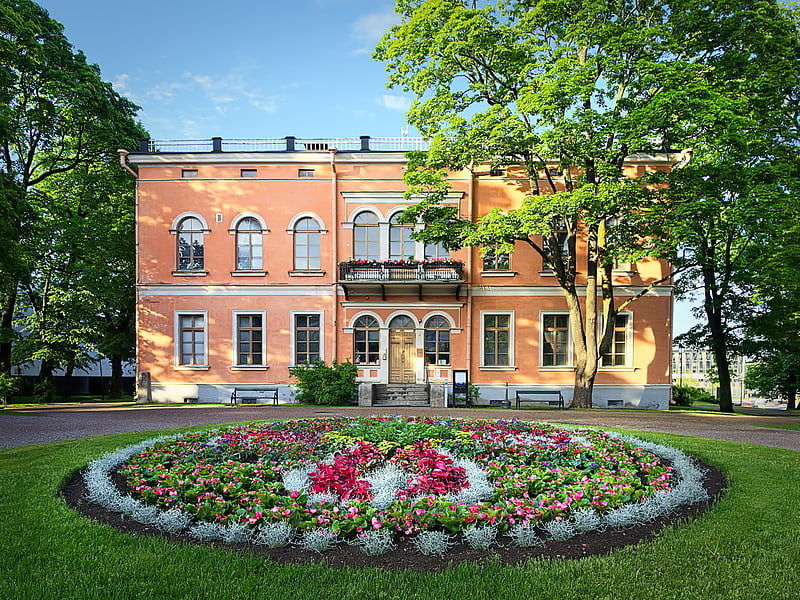
Museum in Helsinki, Finland. Villa Hakasalmi, also known as Villa Karamzin, is an architecturally and historically important 19th-century villa located in the Etu-Töölö district of central Helsinki, Finland. The villa is situated in a prominent position on Mannerheimintie, next to Finlandia Hall and opposite the National Museum.
Designed by architect Ernst Lohrmann in the Empire style and built in 1844–1846, the villa was originally the summer residence of Senator and State Councillor Carl Johan Walleen. In 1896, Walleen's step-daughter Aurora Karamzin sold the villa to the City of Helsinki, although she was allowed to continue living there until her death six years later.
Since 1912, the villa has been occupied by the Helsinki City Museum, as one of its five main exhibition venues.[20]
Address: Mannerheimintie 13b, 00100 Helsinki (Eteläinen)
Esplanadi

Narrow park for picnics in summer. Esplanadi, colloquially known as Espa, is an esplanade and urban park in downtown Helsinki, Finland, situated between the Erottaja square and the Market Square. It is bordered on its northern and southern sides by the Pohjoisesplanadi and Eteläesplanadi streets, respectively. Aleksanterinkatu runs parallel to Esplanadi. Esplanadi is well known as a popular walking area, and street performances are also often held in the park.
Designed by the architect Carl Ludwig Engel, the park was originally opened in 1818. In 1827, Engels Teater (the predecessor of the Swedish Theatre), the first theatre building in Helsinki, also designed by Engel, was erected in a corner of the park. Centered in the park is a statue of Johan Ludvig Runeberg, the national poet of Finland, by his son Walter Runeberg. Other public art pieces include works by Viktor Jansson, Gunnar Finne and Lauri Leppänen.
The eastern end of the park houses the Kappeli restaurant, which opened in 1867. In front of the restaurant is an outdoor stage, which hosts numerous live music performances. Other prestigious restaurants on the edge of the park include Restaurant Olo on Pohjoisesplanadi and Savoy Restaurant on Eteläesplanadi.[21]
Panoraama
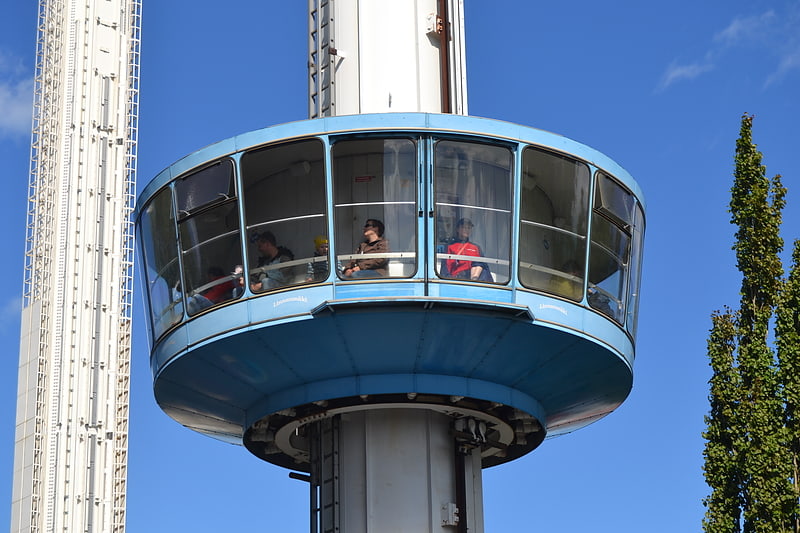
Building in Helsinki. Panoraama is a 53 metres tall gyro tower at the Linnanmäki amusement park in Helsinki, Finland. Its observation deck rises about 84 metres above sea level. Panoraama was built in 1987 by the Swiss Intamin and offers capacity for 400 visitors per hour. It was originally known as Panorama, but the name was changed to Panoraama when Linnanmäki changed the naming policy for its rides and started to use only words that are correct in the Finnish language.
Originally, Linnanmäki was planning a real observation tower, like the considerably taller Näsinneula at the Särkänniemi park in Tampere, but first there were legal issues and later problems with funding. Eventually, Linnanmäki chose to build a tower in the form of a gyro tower ride.
Panoraama is one of the best places to view the city of Helsinki, as the tower is located only about 2 kilometres from the centre of the city.[22]
Helsinki City Hall
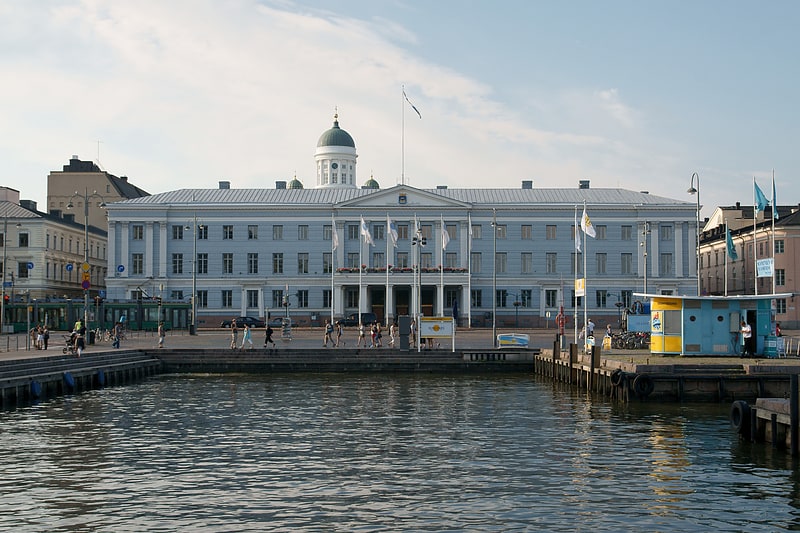
Also known as: Helsingin kaupungintalo
City or town hall in Helsinki, Finland. Helsinki City Hall is a central administrative building of Helsinki, Finland. City Hall is located in the Kruununhaka district, overlooking Market Square, at address Pohjoisesplanadi 11–13. City Hall is the seat of the City Council of Helsinki.[23]
Address: Pohjoisesplanadi 1, Helsinki (Eteläinen)
Salama Roller Coaster
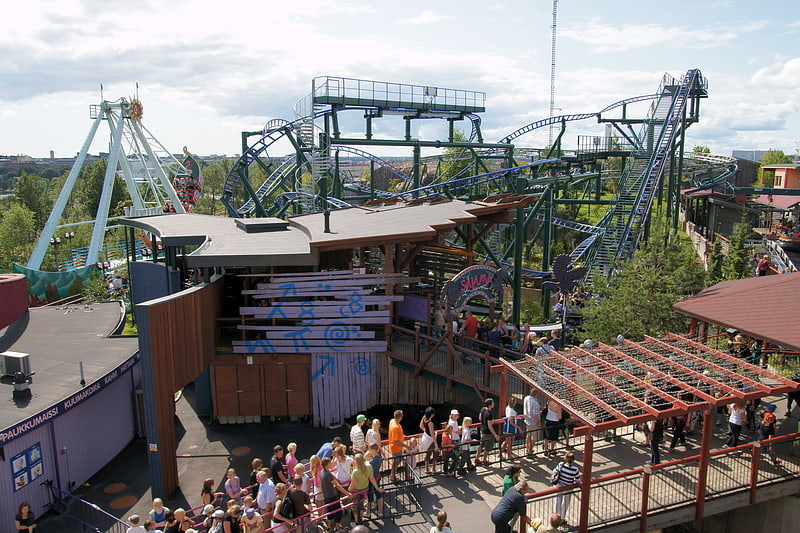
Also known as: Salama
Roller coaster in Helsinki, Finland. Salama is a steel roller coaster located at Linnanmäki in Helsinki, Finland. It was constructed for the 2008 season. It is built on top of Hurjakuru, a river rafting ride.
Salama got its name from Kalevala, the national epic of Finland.[24]
Address: Tivolikuja 1, 00510 Helsinki (Keskinen)
Museum of Technology
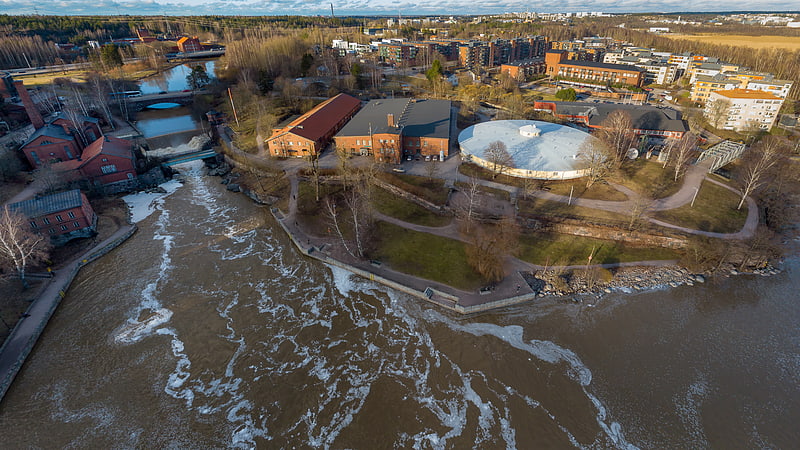
Also known as: Tekniikan museo
Museum in Helsinki, Finland. The Museum of Technology, Helsinki, is situated in Helsinki, Finland. It is the only general museum of technology in the country.
The Museum of Technology is operated by the private Museum of Technology Foundation which was established in 1969. The foundation was established by industrial and engineering organizations, museum professionals and the municipalities of the Helsinki metropolitan area.[25]
Address: Viikintie 1, 00560 Helsinki (Koillinen)
Helsinki Ice Hall
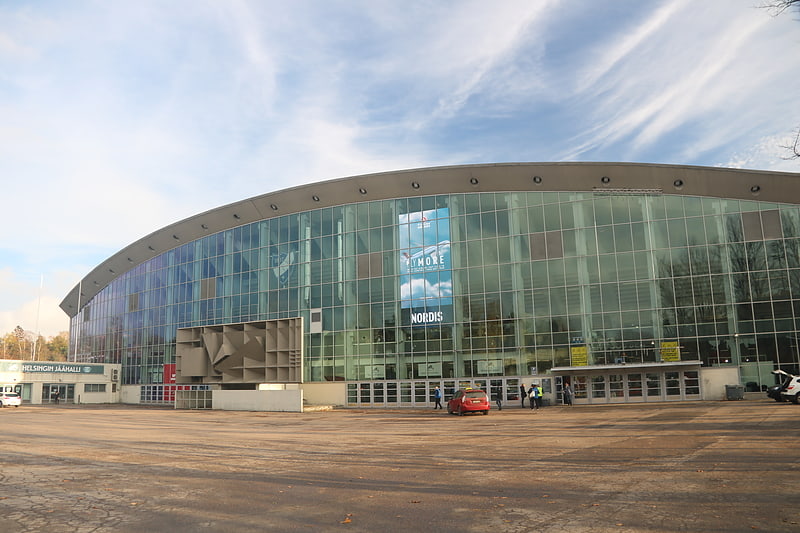
Also known as: Helsingin jäähalli
Arena in Helsinki, Finland. Helsinki Ice Hall is an indoor arena located in Helsinki, Finland. The arena has a seating capacity of 8,400.[26]
Helsinki Railway Square

Also known as: Rautatientori
Helsinki Railway Square is an open square immediately to the east of the Helsinki Central railway station in central Helsinki in Finland. The square serves as Helsinki's secondary bus station along with the main Kamppi Center bus station. The north side features the Finnish National Theatre, and the south side is formed of the Ateneum classical art museum. To the west side are the two ornate entrances to Helsinki Central station—a bigger one for public use, and a smaller one exclusively for the President of Finland and their official guests. The square is served by the Helsinki Metro system with Rautatientori metro station entrances at the south-west corner, and University of Helsinki metro station to the east.
During summer afternoons and evenings, the pub tram Spårakoff departs from the Mikonkatu tram stop in the square once per hour.[27]
Olympiastadion
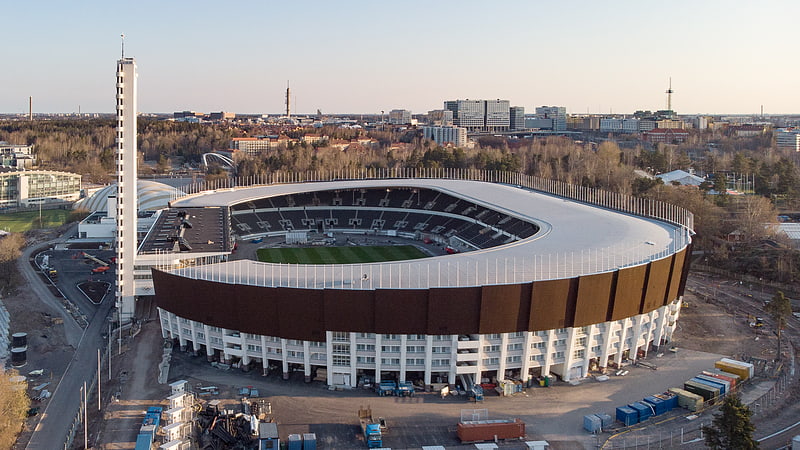
Also known as: Helsingin olympiastadion
Stadium in Helsinki, Finland. The Helsinki Olympic Stadium, located in the Töölö district about 2.3 kilometres from the centre of the Finnish capital Helsinki, is the largest stadium in the country, nowadays mainly used for hosting sports events and big concerts. The stadium is best known for being the centre of activities in the 1952 Summer Olympics. During those games, it hosted athletics, equestrian show jumping, and the football finals.
The stadium was also the venue for the first Bandy World Championship in 1957, the first World Athletics Championships in 1983 as well as for the 2005 World Championships in Athletics. It hosted the European Athletics Championships in 1971, 1994 and 2012. It is also the home stadium of the Finland national football team.
The stadium reopened in August 2020 after 4 years of renovation.[28]
Address: Paavo Nurmi tie 1, 00250 Helsinki (Eteläinen)
Government Palace

Also known as: Valtioneuvoston linna
Building in Helsinki, Finland. The Government Palace is the executive office building of the Council of State of Finland. It overlooks the Senate Square in central Helsinki, Finland. The Government Palace houses the Prime Minister's Office, the Office of the Chancellor of Justice and most departments of the Ministry of Finance. Its former name is the Senate House. The building is usually not open to the public but on occasions there are open days.[29]
Hartwall Areena
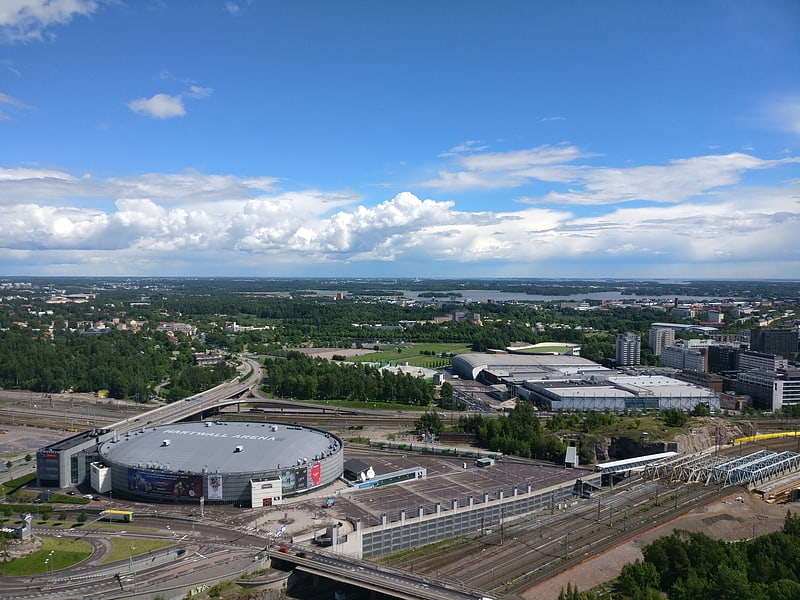
Also known as: Hartwall Arena
Indoor arena in Helsinki, Finland. Helsinki Halli is a large multi-functional indoor arena located in Helsinki, Finland that was opened in April 1997. The arena is convertible for various events. The total seated capacity during ice hockey games is 13,349 and as an amphitheatre, it is significantly reduced to between 3,000 to 5,000.[30]
Address: Helsinki, Areenankuja 1
Design Museum
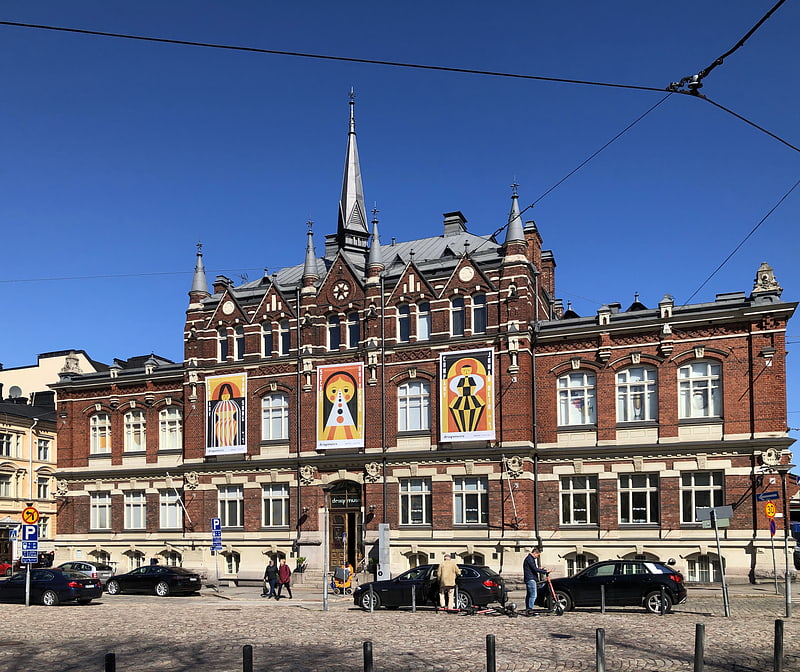
Also known as: Designmuseo
Museum in Helsinki, Finland. Design Museum is a museum in Helsinki devoted to the exhibition of both Finnish and foreign design, including industrial design, fashion, and graphic design. The building is situated in Kaartinkaupunki, on Korkeavuorenkatu Street, and is owned by the Republic of Finland through Senate Properties. The building was completed in 1895 and originally built as a school building for the Swedish school Läroverket för gossar och flickor.
The museum, which is 140 years old (2013) and one of the oldest in the world – was first founded in 1873 but has operated in its present premises, a former school, designed by architect Gustaf Nyström in 1894 in the neo-Gothic style, since 1978. In 2002, the museum changed its name from Taideteollisuusmuseo to Designmuseo ("Design Museum") because the original name was too long and complicated. The museum also has a cafe and shop. Situated on the same city block is the Museum of Finnish Architecture.
The museum includes a permanent exhibition devoted to the history of Finnish design from 1870 to the present day, as well as space for changing exhibitions. The museum's permanent collection consists of over 75,000 objects, 40,000 drawings and 100,000 drawings. Design Museum arranges also international touring exhibitions and publishes books and exhibition catalogues. From museum's home page, there is a free access to several web exhibitions on Finnish design, for example about the production of Arabia Factory, Marimekko and designers Kaj Franck and Oiva Toikka. Latest web exhibition is about 1950–60s design – an iconic golden era of Finnish Design.[31]
Address: Korkeavuorenkatu 23, 00130 Helsinki (Eteläinen)
Kaisaniemi Park
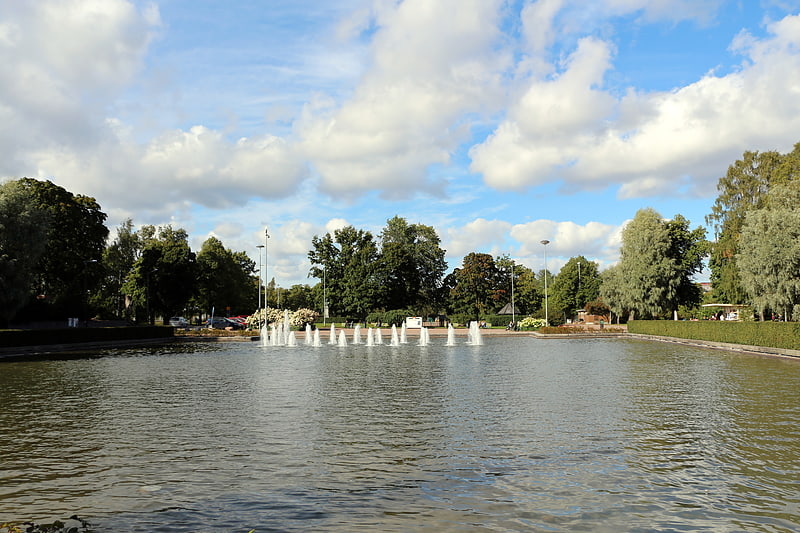
Also known as: Kaisaniemen puisto
City park in Helsinki, Finland. Kaisaniemi park is a popular park, in the center of Helsinki, in the region of Kluuvi. The Kaisaniemi Park was named after Catharina "Cajsa" Wahllund. Part of the park was given to the University of Helsinki in 1829, for gardening. The oldest greenhouse was opened in 1889.
In the park, is the oldest public memorial in Helsinki, called Freemason's Grave, there's also a soccer pitch, basketball and tennis courts.
It is a place of several events, including concerts, the World Village event and The Tuska Open Air metal festival, which was held there from 2001 to 2010.
It usually hosts the Helsinki Day concert. It also hosted the Norwegian pop duo Marcus and Martinus in June 2018.[32]
Three Smiths Statue

Also known as: Kolmen sepän patsas
Sculpture by Felix Nylund. The Three Smiths Statue is a sculpture by Felix Nylund, situated in Helsinki, Finland, in Three Smiths Square at the intersection of Aleksanterinkatu and Mannerheimintie. This realistic statue, unveiled in 1932, depicts three naked smiths hammering on an anvil.
Felix Nylund submitted a design for a smith statue for a memorial for Johan Vilhelm Snellman in 1913. In 1919 he designed a monumental statue with three smiths located on top of a stone pillar ten metres high. Neither of these designs was actually made into a statue, but Nylund took advantage of his previous designs when sculpting the Three Smiths Statue.
Of the three smiths depicted in the statue, one is a master smith holding the iron on an anvil. The other two smiths are hammering on the iron. Nylund used wrestlers from the gymnastics and sports club Jyry as models for the smiths' bodies. The master smith has the face of poet Arvid Mörne, the smith holding his hammer up has Nylund's own face, and the smith holding his hammer down has the face of sculptor Aku Nuutinen. It is said that mason Paavo Koskinen and police officer Sundström posed as models for the bodies.
The top part of the bronze statue's granite base is encircled by the Latin text MONUMENTUM – CURAVIT – LEGATUM – J. TALLBERGIANUM – PRO HELSINGFORS A.D. MCMXXXII ("The statue was erected with the help of a donation from J. Tallberg by Pro Helsingfors in the year 1932"). The statue was donated to the city of Helsinki by the Pro Helsingfors foundation, which had acquired it with the help of a monetary donation by the businessman Julius Tallberg. Tallberg's commerce house is situated at the northern end of the Three Smiths Square.
The statue was damaged in a bombing during the Continuation War in 1944. Marks of the damage can still be seen in the base of the statue, and the anvil has a hole caused by a bomb shrapnel.
The Three Smiths Square is a popular meeting place. There is a heating system underneath Aleksanterinkatu keeping the street free from snow and ice even in temperatures of -10 degrees Celsius. The heat comes from warm water flowing from the nearby buildings. Thus people can sit at the statue even in wintertime.
Upon close investigation of the statue, it can be seen that the positions of the smiths are more artistic than realistic: the smiths are standing so close to each other that if they were to actually hammer, they would hit each other on the head instead of the anvil.
The original gypsum models of the statue have been located in the library of the Finnish Workers' Academy in Kauniainen.
Nowadays the statue is annually capped with Santa Claus hats at the end of November at the Wappujoulu event of the University of Helsinki student organisation Limes.
In spring 2020 during the COVID-19 pandemic surgical masks were placed on the smiths and an effigy of the Coronavirus was placed on the anvil so it looked like the smiths were hammering down on the virus.[33]
Address: Aleksanterinkatu 52, 00100 Helsinki (Eteläinen)
Finlandia Hall
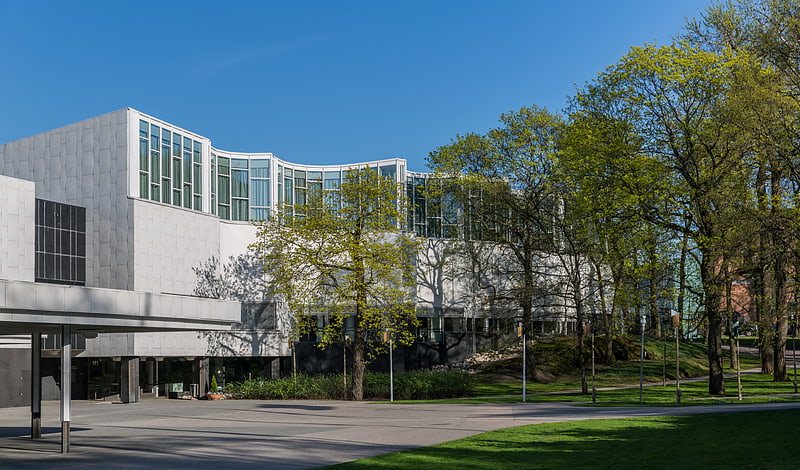
Also known as: Finlandia-talo
Concert hall in Helsinki, Finland. The Finlandia Hall is a congress and event venue in the centre of Helsinki on the Töölönlahti Bay, owned by the City of Helsinki. The building, which was designed by architect Alvar Aalto, was completed in 1971. Every detail in the building is designed by Aalto. The designs were completed in 1962, with building taking place between 1967 and 1971. The Congress Wing was designed in 1970 and built in 1973–1975. In 2011, the building was expanded with new exhibition and meeting facilities. Finlandia Hall is known as the venue for the OSCE Summit held in August 1975, attended by 35 world leaders, including the leader of the Soviet Union, Leonid Brezhnev, and the President of the United States, Gerald Ford.
The inauguration of the Finlandia Hall was celebrated on 2 December 1971. The inauguration concert included the first performance of Einojuhani Rautavaara's Meren tytär (‘Daughter of the Sea’) and Aulis Sallinen's Symphony (opus 24), as well as Sibelius's violin concerto with Isaac Stern as the violin soloist of the Helsinki Philharmonic Orchestra.[34]
Address: Mannerheimintie 13, 00100 Helsinki (Eteläinen)
Equestrian statue of Marshal Mannerheim
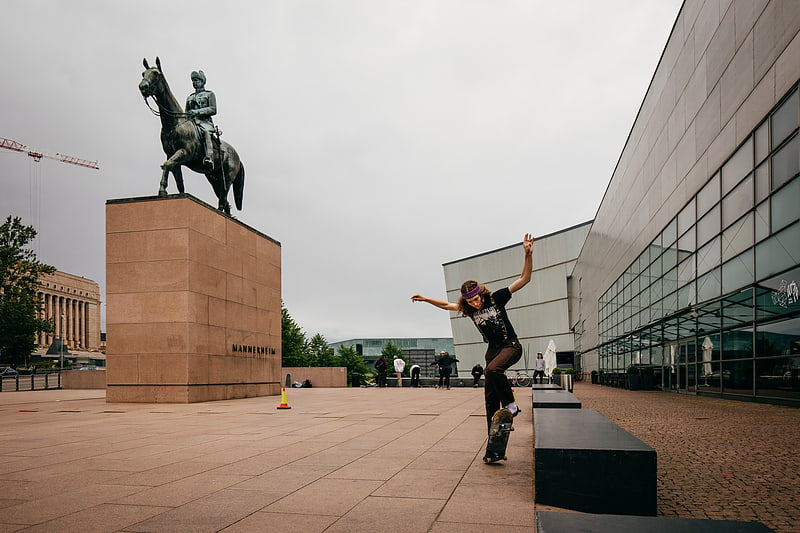
Also known as: Marsalkka Mannerheimin ratsastajapatsas
Statue by Aimo Tukiainen, Heikki Häiväoja, Kain Tapper, and Oskari Jauhiainen. A bronze equestrian statue of Gustaf Mannerheim, the Marshal of Finland, stands in centre of Helsinki, Finland. It was made by Aimo Tukiainen and erected in 1960.
The bronze statue is 5.4 m tall. It is raised on a granite podium, 6.3 m tall, 6.3 m long and 2.72 m wide.
Mannerheim was a symbolic figure in Finland at since the Finnish Civil War 1918 as a general, and his position grew stronger during the Second World War as a field marshal. The first plans and fundraising for an equestrian statue started already in 1937. After his death in 1951 the plans were relaunched by initiative of the Helsinki University Students' Union. During the fundraising campaign 737 503 members of public donated over 78 million marks in 1952. The funds were sufficient for not only the statue but also for purchasing the Louhisaari mansion in Askainen, Mannerheim's place of birth, which was turned into a museum.
The statue was commissioned from Aimo Tukiainen after a competition. Tukiainen made a realistic and detailed statue of the horse-riding Mannerheim. At its unveiling in 1960 the art world considered it out-dated. In his contemporary works Tukiainen himself had already moved on from realism.
The features of the horse, its gait and which of the Marshal's horses it actually represents have been discussed a lot. During his life Mannerheim owned several horses. Tukiainen studied Mannerheim's last horse Käthy when working on the statue, but it is not a portrait of her as such.
The construction of the Kiasma, Museum of Contemporary Art next to the statue was debated during the time of construction of the museum.[35]
Address: Mannerheimintie (Kiasma), Helsinki (Eteläinen)